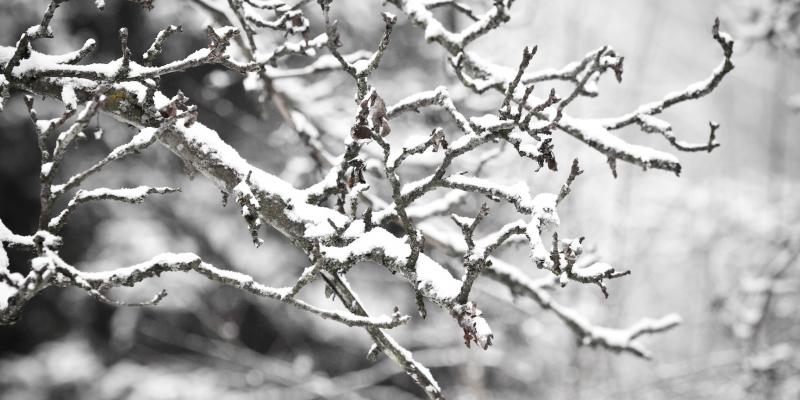Last updated: 12/01/2023
Estimated read time: 4.5 minutes
Come wintertime, properly salting your driveway, walkways, and sidewalks are essential. While it keeps accessways clear and usable, de-icing salt can cause inadvertent damage to your lawn and other plants. So take a few minutes to learn how to avoid salt damage to your plants and set them up for a healthy spring.

How to Keep Your Trees, Lawn, and Landscape Protected From Salt Damage
Monitor Your Salt Use
Unfortunately, there will be times when using de-icing salt is unavoidable. After heavy snow or ice accumulation, salting your driveway and sidewalk may even be required, depending on where you live. When using salt can’t be avoided, take extra care to spread it only where necessary and to not place it in an area that will wash downward toward your plants come warmer weather.
Water the Area
When spring finally arrives and the last stubborn snow patches melt, any lingering salt will seep into the ground. This is of particular concern in urban and suburban areas where local municipalities often salt indiscriminately. Watering the melt areas heavily will dilute salt concentrations, minimizing any potential damages in the process.
Create a Barrier
Another simple yet effective solution can be to install a physical barrier between a salted area and your vulnerable plants. These can be purchased at most hardware stores and while they’re known to be effective, don’t always protect below the soil. If need be, professional installation is also widely available.
Put Down Tarps or Burlap
Rudimentary though it may sound, placing tarps or burlap sacks between your plants and the snow or ice is one of the most effective DIY solutions out there. Not only will this avoid the need to salt altogether as accumulated ice can simply be removed and disposed of at your convenience, but it will also provide your plants with extra insulation from the cold.
Choose a Salt Alternative
The market is flush with salt alternatives that function as effective de-icing compounds while still keeping your plants safe. A few of our favorites include Magnesium Chloride, Calcium Chloride, and Potassium Chloride. While each comes with its own drawbacks—namely being potentially damaging to concrete in high concentrations—they’re much easier on your plants than standard rock salt (Sodium Chloride). Just be sure to assess your needs and evaluate which plants in your yard are the most vulnerable to ensure that you pick the right one.
Spread the Snow
Similarly, spreading out the snow, rather than allowing it to accumulate in one concentrated area, allows it to thaw and melt naturally, also avoiding the need to salt in the first place.
Choosing the Right Salt
Unsurprisingly, choosing the right salt is critical to protecting your plants throughout the winter and into the spring. Simply throwing down rock salt at the first sign of snow will result in unnecessary and easily avoidable damage. Any of the products we listed above will work well, but when in doubt, always consult a lawn care professional to help you make the right decision. Whatever you do, always take the time to weigh your decision carefully to make sure that you end up with the right product for you and your lawn’s needs.
What Does Salt Damage Look Like?
Fortunately, the signs of salt damage to your plants are easy to identify. Typically, it will present similarly to water stress, causing plants to turn brown and wither. Evergreens that experience salt damage often experience leaf damage which, left untreated, can spread across the entire plant. Salt damage is not always fatal for an affected plant but can cause lingering issues like stunted growth, underdeveloped buds, and even early leaf drop. Knowing the signs of salt damage to your plants can go a long way, but it’s far better to avoid the damage in the first place, which can be accomplished in numerous ways.
What to Do When You Notice Salt Damage
Even when you try hard and take steps to avoid salt damage, it’s not uncommon for some to occur. This is especially true after a winter season with heavy precipitation. When you do notice salt damage, however, there are a few things you can do to minimize its effects, including:
- Watering: As we mentioned before, heavily watering an affected area will both dilute salt concentrations in the soil and will rinse any remaining salt off of the surface of your plants where it can cause serious damage.
- Use a Soil Conditioner: Soil conditioners, such as pelletized gypsum, can help to mitigate the worst of salt damage, helping impacted soil retain moisture and promoting new growth in affected plants. These are most effective for treating serious salt damage when it occurs.
- Choose Salt-Tolerant Plants: While not a treatment method, cultivating salt-tolerant plants in your yard, such as Bee Balm, Daylilies, or various succulents, can avoid the need to address salt damage in the first place.
- Consult a Professional: If you’re unsure of where to begin, our team of local experts at Blades of Green can help. Our expertly-trained technicians can provide you with professional insights and help you develop a reliable plan to both prevent and treat salt damage wherever it occurs. Give us a call today to get started!
Have a Question About Lawn Care? Ask the Experts!
Having a lawn care problem that you can’t seem to solve? Send your question to our expert technicians and get the answers you need to get a healthy, beautiful lawn.
Ask a Lawn Care QuestionConsider Professional Lawn Care
Blades of Green is the number one choice for lawn care in Maryland and Northern Virginia. The trained lawn care professionals we employ have experience in helping homeowners keep their lawns green and healthy all year long!
Get a FREE Lawn Care Quote Now
Quick Quote Form
"*" indicates required fields
